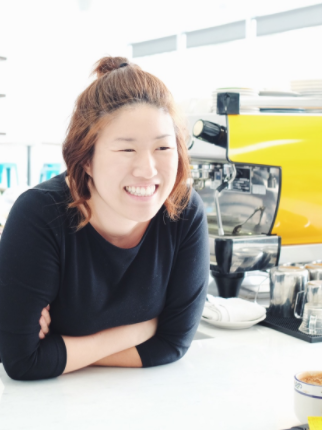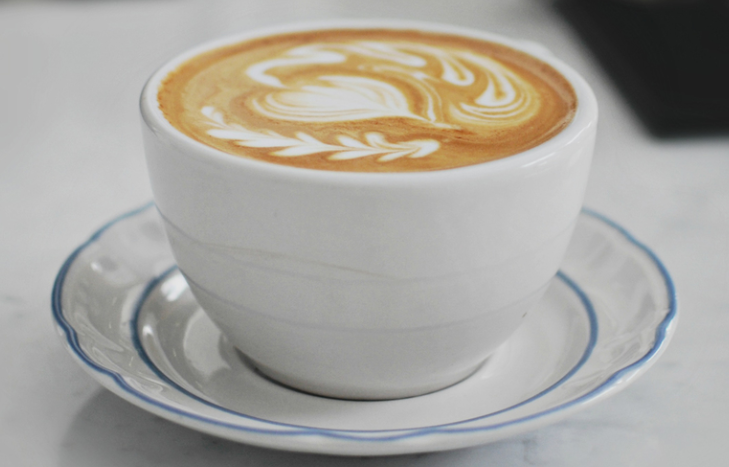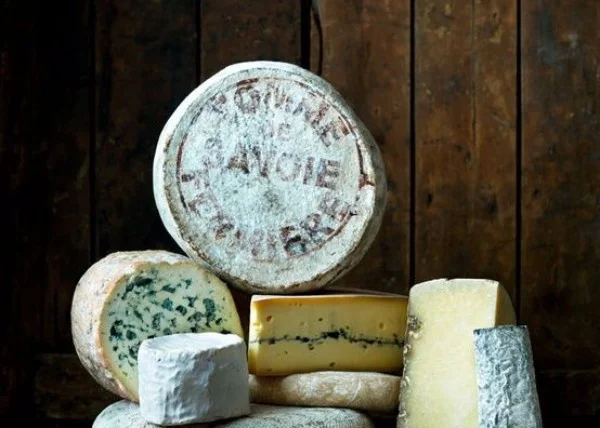Nearly everyone eats cheese but few people understand it. I get asked all the time “Why did you call you store Milkfarm?” People don’t really think about how cheese comes from milk and there is somehow a farm involved. It’s up to me to educate my consumers.
So there are 4 outlets for cheese making. 1. The Diary Man: he is raising the cows, growing the grass, making sure they are eating right. 2. The Cheesemaker: he ensures the cheese is being made in the proper way, controlling the pH. and the bacteria. 3. Affineur: this is the person who ages the cheese, who controls the bacteria in these cheese caves, on these wooden planks as cheeses age. This effects the flavor of the cheese. 4. The Cheesemonger: this person educates and serves the cheese. How we take care of the cheese represents all three people.
I’ve gone to a lot of cheese stores where the cheese looks like s*$%. It’s dead. It’s lived, it’s died. And it does represent all the hard work the other people have put in.
By the way, you need to come to my Parmigiano-Reggiano class on the 26th. You can learn a lot through my classes.
M: Umm. Done.
M: I’m really fascinated by the process of fermentation, controlled spoilage, or as you have said, “delicious rot.” The idea that something decaying or rotting, in skilled hands, can become something rather delicious.
L: But it can also be very not delicious! If the cheesemaker doesn’t have the appropriate skill or knowledge, they can really mess things up. So like, if you come to the Parmigiano-Reggiano class you’ll learn about microbial rennet, why things can get bitter. If the cheesemaker doesn’t cut the curd the right way, it messes up the pH. of the milk because milk is an alive thing. The process of trying to get the perfect pH. before they add the salt, before they add the rennet, before they maneuver and manipulate it. That has a lot to do with the outcome of the cheese.
Or the problem can lie with the cheesemonger. So let’s say you get a brie and you cut this brie at a restaurant and its ooey and gooey and delicious. Then you have another piece at another restaurant and it’s hard, kind of chalky. Then you have another piece at another restaurant and it smells like Windex and its brown. This could be the exact same cheese but just in different phase of the lifespan.
M: So what I hear is that it’s not only the cheesemaker but it’s how the cheese is used. Shifting gears…Let’s talk about biodiversity. As a culture we are so germaphobic but from what I have read, it’s actually the diversity of microbes that brings the complexity of flavor. Bacteria is our friend.
L: (laughs) My sister has a newborn and if she could put her in a bubble or dip her in latex she would but the truth is the human body is a complex system of microbiomes. We need all of that bacteria. Like the nun in Cooked Episode 4, she needs all the funky bacteria growing in that wood for years and years to develop that cheese.
A few years ago the FDA was cracking down on affineurs using wooden planks. There were some high counts of “bad bacteria” on some planks so they wanted to banish all wooden planks. That would have been disastrous because we need all that funkiness to play a role on the cheeses surface to create beautifully complex cheeses. The interesting nuances and flavor profiles would be gone.
M: So there is a fine line between safety and danger and the potential for growth and goodness.
M: If you were to make a t-shirt, what would it say?
L: I heart bacteria.
M: (laughs) So back to this concept of fermentation. When was a time in your life where it seemed like you reached a point of change, where it felt like the end but it became something new?
L: There was a point after I got married where I felt like I had no oxygen. That I was done. But I regenerated. I started to figure things out, what I needed. Interestingly though, in cheese oxygen can accelerate the ripening process. So like with blue cheese, at certain stage they actually purposely introduce it to oxygen to feed the bacteria.
M: So cheese has an anaerobic process but then it’s purposely exposed to oxygen. So the lack of exposure starts the cheesemaking process but then it’s all about exposure and handling?
L: Yes, but oxygen exposure starts the ripening process. So like blue cheese, the second you cut the wheel open you can literally see, with your bare eyes, the blue becoming more blue. And every day, you will see it become bluer and develop more mold.
M: So what does that mean? Is that more flavor or is there some line between deliciousness and rot?
L: It’s more flavor until you hit that point where it becomes too bitter or the flavor too strong.
M: So, it’s a dance
L: Absolutely. There’s high amount of spoilage in my industry. People wonder why cheese is so expensive. You already heard about all the people involved in the process of making the cheese. It becomes my job to sell it within that peak window. So, a lot can spoil.
M: You leave a lot cheese on the table so to speak.
L: Well, not so much anymore. People are starting to get it. It’s a good feeling. Slowly people are starting to get what we are serving is of the best quality.
M: Anything you want people to know about cheese that they may not know?
L: Not all soft cheeses are bries. (laughs) and not every hard cheese tastes like parmesan. These are probably the two most irritating things to the cheesemonger. But those are things we chip away at as we educate the public about cheese and its differences.
L: Also, terroir. It’s a French word that translates to 'of the land.' So, if you are having a pinot noir from the Willamette Valley versus a pinot noir from France or Paso Robles, they will all taste different because of the soil, the hands that touch it, the climate, the bugs that are eating it, the ripening, they all make a difference in taste. Terroir effects cheese a lot.
So, take Raclette. It's a very famous cheese meant to be melted and scrapped atop potatoes. Raclette is made in France. It’s made in Switzerland. I chose to use a Raclette that’s made in Vermont. The flavor is completely different. The taste, the flavor of it is delicious because these people are raising cows that are eating the freshest sustainable grasses; it’s made in these really great caves. It’s all terroir. Everything about that farm is effecting the way that cheese taste. Terroir.
M: The ecology of cheese. (laughs)
L: Cheese is interesting. I think I’ve stayed into it because it’s not so black and white. It’s not simply: follow a recipe and then, done. Cheese is living, changing, breathing. It's so much more than just a cheese shop.
M: That it is.





















